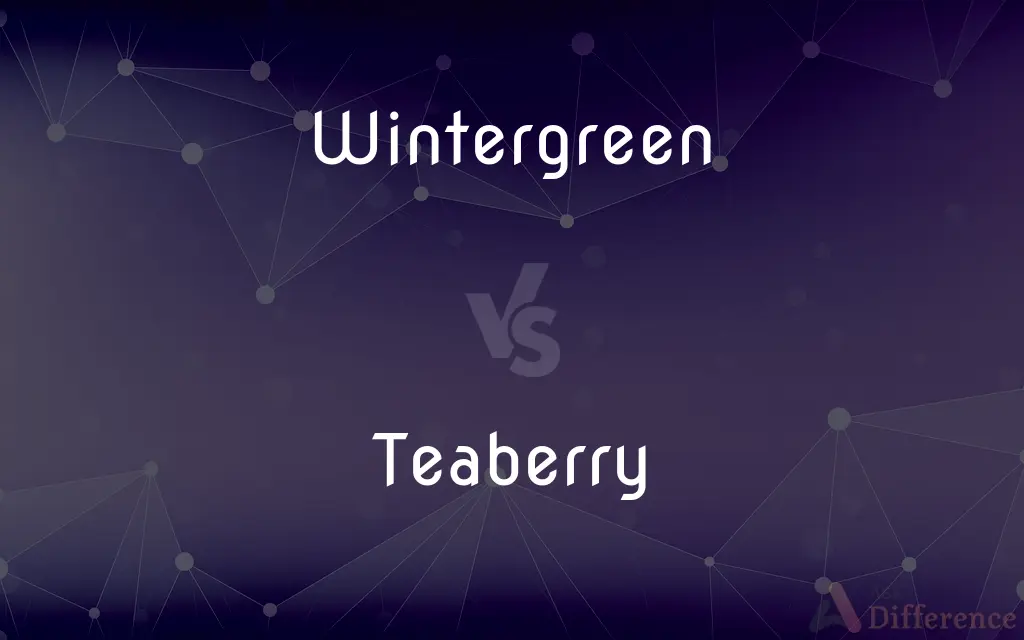Wintergreen vs. Teaberry — What's the Difference?
By Tayyaba Rehman & Maham Liaqat — Updated on April 4, 2024
Wintergreen refers to plants with a minty flavor, while teaberry is the fruit of the wintergreen plant, known for its edible red berries.

Difference Between Wintergreen and Teaberry
Table of Contents
ADVERTISEMENT
Key Differences
Wintergreen is a term commonly associated with several plants within the genus Gaultheria, particularly Gaultheria procumbens, known for their glossy leaves and minty, refreshing scent. These plants are evergreen and thrive in forested areas across North America. In contrast, teaberry refers specifically to the small, red, edible fruit produced by the wintergreen plant, characterized by its mild, minty flavor reminiscent of wintergreen oil, which is derived from the plant’s leaves.
The leaves of the wintergreen plant are not only notable for their aromatic oil but are also used in traditional medicine and as a flavoring agent in various products, including teas, chewing gum, and candies. Whereas, teaberries are consumed fresh, used in culinary applications such as jams, jellies, and baked goods, or simply enjoyed on their own as a natural treat.
Wintergreen oil, extracted from the leaves, contains methyl salicylate, which is used medicinally for its anti-inflammatory and analgesic properties. This oil is widely used in topical pain relievers and has a strong, distinct scent. On the other hand, teaberries, while sharing the minty flavor profile, are primarily valued for their taste and are not a significant source of methyl salicylate, making them more of a culinary delight rather than a medicinal component.
Culturally, wintergreen has a long history of use by Indigenous peoples of North America, both medicinally and spiritually. The plant's widespread availability and various uses have made it a staple in folk medicine. Conversely, teaberries have been enjoyed for their flavor, serving as a natural breath freshener and a source of food in the wild.
Both wintergreen and teaberry are celebrated for their unique contributions to both the culinary world and natural medicine. While wintergreen leaves are prized for their extract and medicinal properties, teaberries are sought after for their delightful flavor, making them a favorite among foragers and culinary enthusiasts alike.
ADVERTISEMENT
Comparison Chart
Definition
Refers to plants known for their minty flavor and scent.
The fruit of the wintergreen plant, known for its edible red berries.
Part Used
Leaves and oil extracted from leaves.
Fruit (berries).
Uses
Medicinal (pain relief), flavoring in products.
Culinary uses, eaten fresh or in jams.
Active Compound
Methyl salicylate in oil.
Not a significant source of methyl salicylate.
Cultural Significance
Used medicinally and spiritually by Indigenous peoples.
Enjoyed for flavor, served as natural breath freshener.
Compare with Definitions
Wintergreen
An evergreen plant known for its aromatic leaves.
The wintergreen plant thrives in the shady underbrush of forests.
Teaberry
The small, red fruit of the wintergreen plant.
Teaberries are ripe for picking in the late summer.
Wintergreen
Associated with traditional medicine.
Wintergreen has been used for centuries in folk remedies.
Teaberry
Known for its mild, minty flavor.
Teaberry gum captures the unique taste of the berry.
Wintergreen
Cultivated for its aromatic and medicinal properties.
Wintergreen plants are harvested for both their scent and healing benefits.
Teaberry
Consumed fresh or used in recipes.
Fresh teaberries make a delicious addition to salads.
Wintergreen
Leaves contain oil used in medicinal products.
Wintergreen oil is a common ingredient in topical pain relievers.
Teaberry
A natural source of food in the wild.
Foragers often seek out teaberries for their sweet flavor.
Wintergreen
Used as a natural flavoring agent.
The minty flavor of wintergreen is popular in chewing gum.
Teaberry
Used in traditional culinary applications.
Teaberry jelly is a favorite homemade treat in regions where the plant grows.
Wintergreen
Wintergreen is a group of aromatic plants. The term "wintergreen" once commonly referred to plants that remain green (continue photosynthesis) throughout the winter.
Teaberry
See wintergreen.
Wintergreen
A creeping evergreen North American plant (Gaultheria procumbens) in the heath family, having solitary nodding white flowers, aromatic leaves, and spicy edible scarlet berries. Also called checkerberry, teaberry.
Teaberry
A berry which is the fruit of a small shrub native to northeastern North America, Gaultheria procumbens (eastern teaberry, American wintergreen, boxberry, checkerberry).
Wintergreen
An oil or flavoring obtained from this plant or certain other plants, such as sweet birch, or produced synthetically.
Teaberry
A pinkish-white edible berry which grows in the Falkland Islands, where the fruits are harvested annually by Islanders to make cakes, confectionary and pavlovas. On the South American mainland the leaves are brewed for tea (Myrteola nummularia).
Wintergreen
Any of several similar or related plants, especially the pipsissewas and plants of the genus Pyrola.
Teaberry
The checkerberry.
Wintergreen
(obsolete) Any evergreen plant.
Teaberry
Creeping shrub of eastern North America having white bell-shaped flowers followed by spicy red berrylike fruit and shiny aromatic leaves that yield wintergreen oil
Wintergreen
One of various not closely related evergreen plants, including:
Teaberry
Spicy red berrylike fruit; source of wintergreen oil
Wintergreen
Plants in shrub genus Gaultheria, commonly known as wintergreen, especially:
Wintergreen
Plants in any of several other genera in the herbaceous family Ericaceae, including:
Wintergreen
Some species of the herbaceous genus Trientalis, in family Primulaceae (chickweed wintergreen)
Wintergreen
The spicy red berries of Gaultheria procumbens.
Wintergreen
The oil, methyl salicylate, obtained from these berries.
Wintergreen
The aroma of the oil, methyl salicylate, however derived.
Wintergreen
A plant which keeps its leaves green through the winter.
Wintergreen
Any of several evergreen perennials of the genus Pyrola
Wintergreen
Creeping shrub of eastern North America having white bell-shaped flowers followed by spicy red berrylike fruit and shiny aromatic leaves that yield wintergreen oil
Wintergreen
Spicy red berrylike fruit; source of wintergreen oil
Common Curiosities
What is teaberry?
Teaberry is the edible, red fruit of the wintergreen plant, Gaultheria procumbens, noted for its mild, minty flavor.
How are teaberries used?
Teaberries can be eaten fresh, used in culinary dishes, or made into jams and jellies for their unique flavor.
Is wintergreen oil safe to use?
Wintergreen oil, containing methyl salicylate, should be used with caution and diluted properly, as it can be toxic in high concentrations.
Are teaberries and wintergreen berries the same?
Yes, teaberries refer to the fruit produced by the wintergreen plant.
Can you eat wintergreen leaves?
While wintergreen leaves are not commonly consumed directly due to their strong flavor, they are used to extract oil and as a flavoring agent.
What are the medicinal uses of wintergreen?
Wintergreen is used for its anti-inflammatory and analgesic properties, primarily in the form of oil for topical applications.
What is the cultural significance of wintergreen?
Wintergreen has been valued for its medicinal properties and as a flavoring agent by Indigenous peoples and in traditional American folk medicine.
What is wintergreen?
Wintergreen refers to plants of the genus Gaultheria, known for their aromatic, minty leaves and oil.
Can teaberries be used medicinally?
While teaberries share the minty flavor of wintergreen, they are not used medicinally like the oil extracted from the leaves.
How can I identify a wintergreen plant?
Look for low-growing plants with glossy, dark green leaves, white flowers, and red berries if in season.
Where can I find wintergreen plants?
Wintergreen plants are commonly found in forested areas of North America, particularly in shaded, wooded regions.
How do wintergreen and teaberry flavors compare?
Both have a minty flavor, but wintergreen oil has a stronger, more intense taste compared to the milder, sweeter flavor of teaberries.
Are wintergreen and teaberry products widely available?
Products flavored with wintergreen, such as gum and candies, are widely available, as are teaberry-specific items in regions where the plant is native.
Is it safe to forage for teaberries in the wild?
Yes, teaberries can be safely foraged and consumed if you can positively identify the wintergreen plant.
Can wintergreen and teaberry be grown at home?
Yes, with appropriate shade and soil conditions, it is possible to cultivate wintergreen plants and enjoy their leaves and berries at home.
Share Your Discovery

Previous Comparison
Gag vs. Muffle
Next Comparison
Sore vs. UlcerAuthor Spotlight
Written by
Tayyaba RehmanTayyaba Rehman is a distinguished writer, currently serving as a primary contributor to askdifference.com. As a researcher in semantics and etymology, Tayyaba's passion for the complexity of languages and their distinctions has found a perfect home on the platform. Tayyaba delves into the intricacies of language, distinguishing between commonly confused words and phrases, thereby providing clarity for readers worldwide.
Co-written by
Maham Liaqat















































